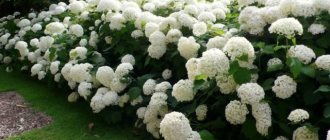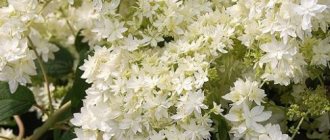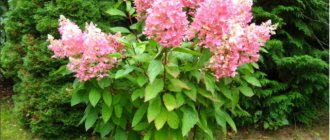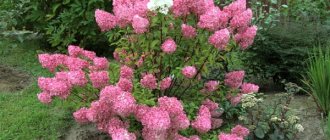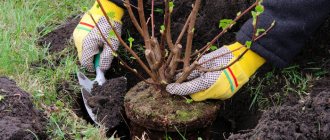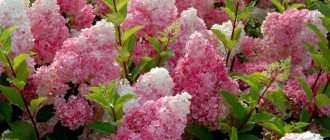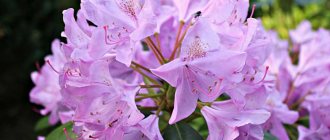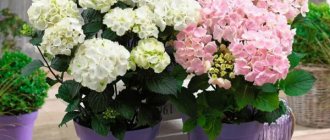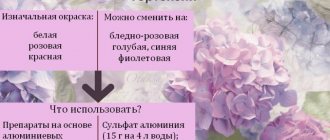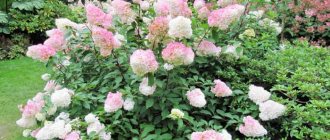Description of hydrangea serrata Bluebird
Serrata hydrangea (hydrangea serrata bluebird) is a shrub with a strong trunk. For a long time it was considered a greenhouse dweller, but today it is planted everywhere.
The height of the plant reaches 120 cm. The leaves are bright green, oval-shaped, up to 12 cm long. The crown width often exceeds 1.5 m.
Hydrangea serrata Bluebird has large inflorescences with a diameter of up to 8 cm. They are able to change color depending on the composition of the soil. In the center of the inflorescence there are small white-blue or light pink flowers. Along the edges of the “panicle” there are large flowers, which, after blooming, acquire a milky pink and bluish tint.
Let's remember the most important information...
- Hydrangea Bluebird is prized for its blue flowers. True, their shade depends on the acidity of the soil in which the bush grows - if it is low, the petals will actively turn pink.
- The bush is planted in early May. It is better to choose a place slightly shaded by other trees, since hydrangea does not like to grow in the sun.
- Caring for this ornamental shrub is easy, but you won’t have to take your sleeves down. In hot weather, hydrangeas need to be watered every day. Also, a profusely flowering bush needs frequent fertilizers (be careful with nitrogen, hydrangeas no longer need it in summer) and constant autumn pruning.
- This variety is winter-hardy, so an adult bush in the middle zone does not need to be heavily insulated for the winter. But young plantings (up to five years of age) are still better to cover.
A keen gardener will tell you about other beautiful varieties of hydrangea. And he won’t just tell you, but show you well-groomed, flowering bushes in your own garden:
Hydrangea Bluebird in landscape design
Landscape design experts recommend planting serrata hydrangea to give the area a blooming appearance. In the process of creating any composition, you need to take into account the fact that the distance between plants should be at least 1.5 m.
The flowering shrub goes well with astilbes or astrantias. Fans of minimalism will love the combination of Blueberry with lilac or mock orange. If there is a pond in the garden, then hydrangea can decorate its coastal zone. Thanks to its high frost resistance, the shrub will delight its owners from early spring to late autumn.
Important! To obtain a pink tint of flowers, designers recommend watering the plant with a weak solution of potassium permanganate; to color the flowers deep blue, use an aqueous solution of potassium alum.
Below are photos of the use of Bluebird serrata hydrangea in landscape design.
The plant is planted as a hedge along the garden path
The combination of different varieties allows you to achieve the natural brightness of a living fence
The view from the window of a blooming flowerbed will extend summer until October
Landing
Experienced gardeners recommend planting serrated hydrangea in late April-early May or in mid-September , when temperatures become more moderate.
When choosing a location, it is worth considering that this species prefers to receive diffused sunlight. You can also plant the shrub in partial shade.
On average, the dimensions of the pit will be 50 centimeters in width and depth. When digging the soil, the following fertilizers are added :
- 2 parts humus;
- 2 parts leaf soil;
- 1 part peat;
- 1 part sand;
- 20 grams of urea;
- complex mineral fertilizers according to the instructions.
If you make any composition from hydrangeas, it is worth considering that the distance between them should be at least 1.5 meters .
During planting, the root collar should be level with the ground . After the seedling is in the ground, it must be watered and mulched.
This species prefers to receive diffused sunlight; the shrub can be planted in partial shade.
Winter hardiness of Hydrangea serrata Bluebird
The winter hardiness of adult hydrangea serrata bluebird allows it to withstand frosts down to -23 ° C, so it can be planted in the Moscow region. The only territory where Bluebird hydrangea should not be grown is Siberia.
With the onset of cold weather, the young plant requires shelter or transfer to a cool room. Proper and timely care of the shrub guarantees the healthy awakening of serrated hydrangea in early spring.
The serrated variety Bluebird blooms all summer and continues to delight the eye until late autumn
Basic principles of care
- Watering. The most important part of hydrangea care. Bluebird should grow in constantly moist soil. If it dries out, the quality of flowering will immediately suffer. Therefore, in summer it makes sense to run the hose directly under the bush. At 25 degrees, water it in the morning and evening, and at 30 and above - generally three times a day.
- Loosening the earth. Hydrangea roots need to breathe, so sometimes fluff up the soil around the bush so that frequent watering does not “cement” it. But don’t take shovels, because Bluebird’s roots don’t lie deep - use a sapa (hoe) and another small tool.
- Shading at noon. If you see that direct rays of the sun fall on the hydrangea branches at lunchtime, protect it with a canopy.
- Trimming. It must be held in the fall. Firstly, all defective branches (dry, broken, diseased) are removed from the bush. Secondly, when leveling the crown, 2-3 knots are removed from the branches from above. The logic of such pruning is simple: the shorter the branches, the less moisture the bush evaporates, which means it will overwinter better. Hydrangea can be trimmed lightly in the summer if you feel that the shape of the bush is not ideal.
Fertilizer
This is a separate topic. Like other varieties of hydrangea, Bluebird blooms profusely, so you can’t do without fertilizing.
The bush is fed in three stages:
- Formation of buds. The plant needs liquid organic matter. A good recipe for one bush: infuse 500 g of humus, 1 kg of dry leaves and the same amount of peat in 2.5 liters of water.
- Bloom. Every week, the soil near the roots should be mulched with a small amount of dry leaves or compost. When watering, the beneficial substances from these fertilizers will evenly go into the soil.
- End of flowering. Repeat watering with humus and peat.
You cannot add chalk or lime to the soil in which hydrangea will grow - this crop is immune to such elements.
Important! Rotted manure or urea, as well as mineral complexes containing large amounts of nitrogen, should be added only at the beginning of flowering. If you feed hydrangea with such substances in the summer, the flowering will be very strong.
But this is not good! Too overgrown brushes will turn out to be so heavy that the branches will not hold up and will begin to break.
If you feed hydrangea with such substances in the summer, the flowering will be very strong. But this is not good! Too overgrown brushes will turn out to be so heavy that the branches will not hold up and will begin to break.
Wintering
You need to insulate the bush in two cases: you have a cold region or the hydrangea was planted recently (up to 5 years ago).
When preparing Bluebird for wintering, the bush is first pruned, then potassium or phosphorus fertilizer is scattered in front of it. This composition will help the plant recover after pruning and strengthen before frost.
- If in your latitudes the temperature drops to -5 degrees in winter, you should simply hill up the hydrangea and cover it with film.
- If your winter climate is -15 degrees, tie a rope around the bush, wrap the soil underneath it onto the roots, and insulate it with spruce branches on top. But this is not enough - you need to wrap a film on top of this “structure”.
- Weather forecasters promise about -20 degrees? Pull each branch of the bush to the ground and secure it with a metal bracket. First place a ball of fallen leaves or sawdust on top of the bush, and above it - a layer of cardboard, spruce branches or unnecessary rags (and warmer - a few bags, an old blanket).
- Do you have very cold winters - down to -30? Even under such conditions, you can compete for Bluebird. But this needs to be done thoroughly: wrap the bush with a metal lattice, then cover it with bricks, and to prevent frosty wind from getting in through the gaps, insulate the entire structure with the same old blankets.
Planting and caring for Bluebird serrata hydrangea
The best time to plant Bluebird serrata hydrangea is considered to be April, May and September. In order for the young shrub to take root faster, it is planted in warm weather. It is necessary to carefully care for it.
For abundant flowering, the gardener must provide hydrangeas with:
- timely watering;
- surface loosening;
- competent pruning;
- protection from pests.
The serrated Bluebird variety is heat-loving, so when planting in open ground, it is important to correctly determine the location.
Selection and preparation of a landing site
Bluebird hydrangea is planted in open areas with partial shade. This flower does not tolerate being exposed to large amounts of sunlight. Staying in the open sun for a long time can cause the bush to dry out. To prevent this from happening, planting is carried out in partial shade.
Serrata hydrangea is an unpretentious plant, so you don’t have to worry about whether it will take root in the chosen place or not. The most important thing is that the area is not exposed to strong winds and the soil is sufficiently moist. Also, the plant will feel comfortable in conditions where other moisture-loving flowers do not grow nearby. Otherwise, the hydrangea will not be able to bloom.
If the selected location is not protected from sunlight, the seedlings will have to be shaded. This will help avoid burns on the leaves.
Important! The serrated variety Bluebird often grows up to 1.5 m in height, so the gardener needs to find a place so that the shrub can grow.
For this reason, it is often planted near high fences and building facades.
Landing rules
The shrub takes root well on any type of soil, except those that contain large amounts of lime and ash. These substances reduce the acidity of the soil, so the plant cannot develop normally.
Experienced gardeners say that a good option for growing is a substrate made from humus, soil, peat and sand.
The landing process is carried out as follows:
- A hole 50 cm wide and 60 cm deep is prepared for seedlings.
- After this, organic fertilizers are added to the soil. Clay soil is diluted with sand. If organic fertilizers are not available, urea can be used instead.
- During the planting process, it is necessary to ensure that the root collar remains flush with the ground.
- After planting is completed, the serrated shrub is watered abundantly with water.
- Mulch the soil around the flower.
The higher the acidity (Ph) of the soil, the brighter the flowers will be. Such soil compositions guarantee good growth of hydrangeas.
Landscape designers often use Hydrangea serrata Bluebird in their projects.
Watering and fertilizing
Hydrangea is a moisture-loving shrub, so it should be watered regularly. The soil should not be allowed to dry out. In hot and dry weather, the plant is watered daily, adding 2-3 liters of water to the root. During the rainy season, watering is reduced to 10 liters per week.
Water for irrigation has its own requirements:
- It should not be hard, otherwise the acidity of the soil will drop to a critical value.
- Do not use tap water. High chlorine content often causes leaf chlorosis (yellowing).
- It is highly not recommended to water the flower with musty water - this can cause rotting of the roots.
If a nutritious soil mixture was used during planting, then fertilizing may not be necessary for the next 2 years. After 2-3 years, hydrangea is fertilized three times per season: in spring, during flowering, and in autumn.
The plant does not like wood ash and lime fertilizers. It is prohibited to use these means. As for nitrogen-containing fertilizers, they should be used strictly according to the instructions.
Pruning Hydrangea finely serrated Bluebird
Bluebird hydrangea is pruned in September. Using pruning shears, you need to cut off 2-3 upper nodes, thereby leveling the “cap” of the bush. Branches without flowers and old dried shoots are also cut off.
Pruning in the autumn is a mandatory procedure. It is needed to reduce the area of moisture evaporation from the plant. To give it a beautiful shape, it is allowed to prune the bush in summer.
Radical shrub trimming is carried out every two years. Removing dead, weak shoots will benefit the plant.
Preparing for winter
After preventive pruning, the hydrangea is prepared for winter. The bushes are treated with solutions against pests. When the foliage finally falls, the plant is sprayed with a liquid based on copper sulfate and slaked lime.
Despite the fact that serrata hydrangea has good frost resistance, the shrub is still covered for the winter
You can do this in several ways:
- Loosen the soil and cover with polyethylene.
- Wrap the branches with netting and throw warm clothes on top.
- Tie the branches together with rope and insulate them with spruce branches.
You need to cover the plant before the arrival of severe frosts.
Care
Landing
It is carried out from April to May in a hole with a depth of 10 cm greater than the length of the root system. Before planting, the soil is loosened, mineral fertilizers, peat, sand, and humus are added to the hole. The optimal distance between bushes is at least 1 meter. Within a radius of 3 meters there should be no large moisture-loving plants that can compete with hydrangea for moisture.
Light mode
Partial shade, diffused light. It is preferable to plant it near a wall or fence, which will provide hydrangeas with shelter both in summer and winter. It feels great under a roof canopy, which limits exposure to direct sunlight that is harmful to the shrub. It is a win-win to use a folding canopy when the sun is at its zenith.
Thermal mode
Garden varieties have mastered a wider temperature range than indoor varieties - from -2° to +25°. The harmful effects of high temperatures in summer can be reduced by watering two or three times a day and using a folding canopy. It must be remembered that the main guideline for starting to prepare hydrangea for winter is a night temperature below -2°.
Watering
Serrated hydrangea is moisture-loving and requires abundant daily watering.
In dry summers, it is especially important to maintain constant moderate soil moisture. At +30° and above, three times watering is indicated, at +25° – twice
It is possible to use sprinklers.
Fertilizer/feeding
Fertilization is carried out three times a year: during planting, during the “bud” period and at the beginning of flowering. The simplest fertilizer is a mixture of peat, humus and dry leaves in a ratio of 2:1:2. When planting, the mixture fills the space free from roots in the hole.
During the periods of bud ripening and flowering, fertilizer is applied to the root space under the bush. To give it a liquid consistency, you need to fill a five-liter bucket half filled with the mixture to the brim with compost diluted with water.
Nitrogen-containing fertilizers are used strictly according to the instructions; there is no need to abuse them if you want to get abundant flowering.
Feeding is carried out once a week. Compost and dry leaves are used as fertilizing.
To loosen the soil, sawdust and sand are added to the compost.
Bloom
Flowering period is July and August.
Interesting! The soil environment can affect the shade of hydrangea flowers. Alkaline soil gives the inflorescences warm pink shades, while in acidic soil the flowers turn bluish.
Once every three days, water one side of the bush with a weak pink solution of potassium permanganate, and the other with a solution of aluminum sulfate and get both blue and pink flowers on the same plant. Composition of the solution: 2-3 grams of powder per 1 liter of water.
Reproduction
Hydrangea propagates by seeds and cuttings.
The cuttings are prepared before the buds open. To do this, select a section of a young branch with 1-2 nodes and leaves. Cross the branch without indenting from the top node at a 90° angle. Under the lower node, cross the branch obliquely, cut off the massive leaves, leaving a few small ones.
Treat the cuttings planted to a depth of 1-2 cm with indoleacetic acid and spray and water daily.
Reproduction
Propagation of Bluebird serrata hydrangea is carried out in several ways. Gardeners prefer to use one of the following methods:
- Cuttings - young branches are cut in mid-July and then placed in soil with peat and sand. The rooted cutting is planted in a permanent place, and by autumn it turns into a full-fledged bush.
- By layering - the lower branches of an adult bush are dug to the ground in the spring. In the fall, shoots appear on them, which can be planted next spring.
- Dividing the bush is the most accessible method. The root system is cleaned of soil, leaves, and shoots. After this, the upper part of the roots is cut, and then the divisions are planted in another place.
- By seeds - this method is necessary if you need a lot of seedlings. Seeds are purchased at a garden center and then soaked. Seedlings emerging from the seed will be a signal of readiness for planting in the ground.
Successful cultivation of seedlings depends on the correct selection of soil mixture.
Hydrangea serrata often becomes the main decoration of the garden plot
Preparing for winter
What is special about this process? As shrubs mature, their resistance to low temperatures gradually increases. Adult plants tolerate 20-degree frosts without problems. However, in order for hydrangea to overwinter normally, it is imperative to rejuvenate and feed it in the fall.
The following measures will help prevent freezing and death of bushes:
- Hilling and covering flowers with transparent garden film.
- Tying branches together and insulating spruce branches of any coniferous trees.
- If you live in a region with a harsh climate and frosty winters, then the hydrangea branches should be pressed to the ground, secured with staples and covered with warm clothes.
- Some gardeners cover hydrangeas with bricks and cover them with old clothes. In such a shelter, plants can withstand even thirty-degree frosts.
If you take good care of your hydrangea, then with the first warmth of spring it will come to life after hibernation and begin to bloom.
Diseases and pests
Hydrangea Bluebird is resistant to disease. In addition to regular watering, the serrated shrub needs shelter from the sun's rays. A flower growing under the sun becomes sick over time: the leaves become yellow, the flowers become pale and small. To prevent this, it is necessary to create artificial shading.
Sometimes the shrub is affected by chlorosis, aphids and downy mildew. Regular inspection of the flower will help you take timely action.
Bushes growing on calcareous soils are most often subject to chlorosis. To treat the plant, use an aqueous solution based on copper sulfate and potassium nitrate. Downy mildew manifests itself by the appearance of oily spots on the stems and leaves. To treat the flower, use a solution consisting of laundry soap, water and copper sulfate.
If the hydrangea is attacked by aphids, whiteflies or spider mites, then the bush should be treated with an insecticide. Regular spraying with special preparations will protect the plant from any infections.
Care
Hydrangea is generally not a whimsical plant. But you need to monitor the soil moisture to prevent the roots from drying out. The plant also requires nutrients and shelter from overheating. No less important is timely pruning, especially sanitary and formative.
Fertilizer
The plant responds well to root and foliar feeding. You should not overdo it with nitrogen, so that the growth of leaf mass does not come at the expense of flowering.
Important! Before adding dry preparations, you need to moisten the soil, otherwise you can burn the roots. For shrubs, several feedings per season are enough:
For shrubs, several feedings per season are enough:
- In early spring, foliage growth is stimulated by adding an infusion of bird droppings. The product is diluted with water in a ratio of 1:20.
- When buds begin to form, potassium and phosphorus are needed. To prepare root feeding, you need potassium salt and superphosphate, 30 g/10 l of water.
- During flowering, repeat the previous option, adding 2 g of boric acid to the product.
- The last fertilizer is applied at the end of August. Place 50 g of superphosphate and potassium salt into the soil around the tree trunk.
Watering
The description of the species speaks of the plant’s love of moisture. A short-term drought will not lead to death, but will worsen the quality of flowering. Settled water is used for irrigation; chlorine has a bad effect on plants. An adult bush will need 2-3 buckets of water. A young specimen needs 10 liters of liquid. With frequent precipitation, the frequency of soil irrigation should be reduced: due to excess moisture, the roots will begin to rot.
Trimming and shaping
In the spring, when inspecting the bush, you should remove weak and broken shoots. Some may be damaged by wind, snow crust, and they are also pruned. To form a beautiful crown, leave the strongest and most even branches. This way they create a backbone. Next, shoots that grow inward and are unpromising are removed from the ring.
Every year the shape is maintained by trimming branches that stick out from the general contour of the crown. Rejuvenating cutting for varieties with fast growth is carried out once every 2-3 years, for slow-growing varieties - once every 5-7 years. The shoots are simply removed onto the stump.
Winter hardiness and shelter for the winter
Serrata hydrangea is resistant to low temperatures; many varieties can withstand -25...-30°C.
Young bushes in cold regions need careful preparation for winter:
- Mulch from sawdust or tree bark in a layer of 25 cm.
- Installation of a circular support on which the agricultural material is pulled.
- Spruce branches and snow crust when snow falls.
It is enough to mulch adult bushes. If the crop grows in an open area, it is advisable to tie the branches with twine so that they are not broken by the wind and the weight of the fallen snow.
Distinctive features
You may be interested in: How to grow thuja from a twig: rules for pruning a twig, rooting, cultivation and care features
Let's look at them in more detail. Hydrangea serrata Bluebird differs from its counterparts in many ways. Among the main differences, breeders highlight the following:
- Sprawling bushes with a lush green crown and large leaves.
- Love of abundance of sunshine and moisture.
- A stronger woody trunk.
- A powerful and well-developed root system, which is located at a relatively shallow depth, thanks to which fertilizing gives results very quickly.
In addition to all of the above, this variety has a longer and more active flowering period. With proper care, you can enjoy the incredible beauty of the bush from mid-summer until autumn. It is also worth noting the winter hardiness of Bluebird serrata hydrangea. The plant is able to withstand twenty-degree frosts, so it adapts well to many regions of our country.
